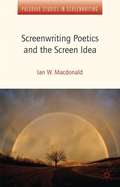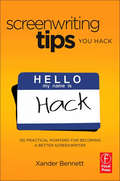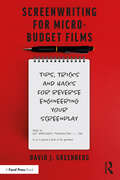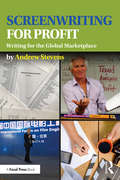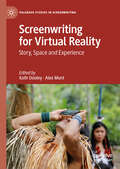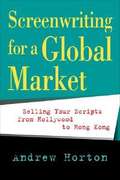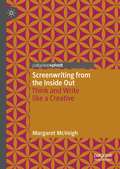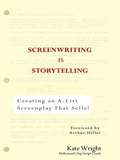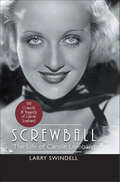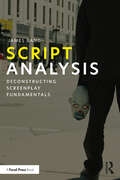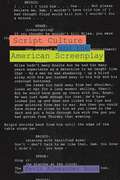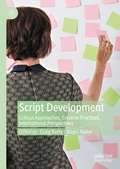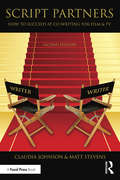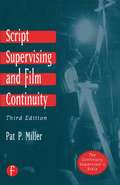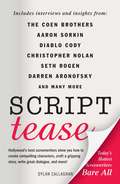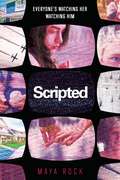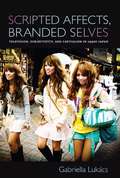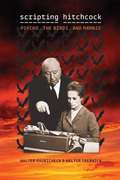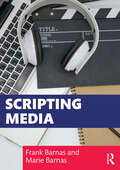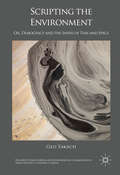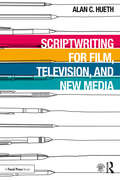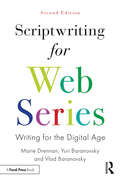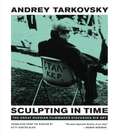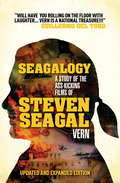- Table View
- List View
Screenwriting Poetics and the Screen Idea
by Ian W. MacdonaldA new, original investigation into how screenwriting works; the practices, creative 'poetics' and texts that serve the screen idea. Using a range of film, media and creative theories, it includes new case studies on the successful ITV soap Emmerdale, Hitchcock's first major screenwriter and David Lean's unfinished film, Nostromo.
Screenwriting Tips, You Hack: 150 Practical Pointers for Becoming a Better Screenwriter
by Xander BennettScreenwriting Tip #99Voice-over usually feels like scaffolding. You know-something you left in there when you were constructing the first draft, but really should have torn out after it served its purpose. Screenwriting Tip #120Always remember that funny trumps everything. Your script could be written in crayon with your name spelled wrong on the cover, but if it's genuinely funny, none of that matters. Screenwriting Tip #156The easiest way to write kick-ass protagonists is to make them incredibly good at what they do. Confused at the outline stage? Stuck in the swamp of Act Two? Don't know who your protagonist is or where she's going?You might feel like a hack. But don't worry-you're not alone. Even the most experienced writers feel like this at times. Sometimes we just need a few short pointers and reminders to set us on the path again.Xander Bennett worked as a script reader in the trenches of Hollywood, reading and covering hundreds of mediocre screenplays. After months of reading about heroic Sea World trainers, transgendered circus detectives and crime-fighting chupacabras, he couldn't take it any more. Xander started a blog called 'Screenwriting Tips, You Hack', a place designed to provide short, witty tips on screenwriting for amateur writers all the way up to journeymen scribes.This book is the evolution of that blog. Dozens of the best scripts (along with many brand-new ones) have been expanded into bite-sized chapters full of funny, insightful, highly usable advice. Let Xander's pain be your gain as you learn about the differences between film and television structure, how to force yourself to write when you really don't want to, and why you probably shouldn't base your first spec script around an alien invasion.
Screenwriting for Micro-Budget Films: Tips, Tricks and Hacks for Reverse Engineering Your Screenplay
by David J GreenbergScreenwriting for micro-budget films can present its own challenges and this book takes the reader through all the considerations that need to be made to write an effective screenplay for a low-budget film. Drawing on his own experience, case studies from films such as Primer, Coherence and Reservoir Dogs, as well as the perspectives of working screenwriters such as Joe Swanberg and Alex Ross-Perry, Greenberg explores common pitfalls screenwriters face and suggests practical solutions. This book lays the groundworks of the realities of low-budget filmmaking and also talks through the practical aspects, such as story structure and genre considerations. Greenberg makes the process of writing a screenplay for a low-budget film accessible and creative, allowing student and independent filmmakers to tailor their writing for their films. This book is ideal for aspiring screenwriters, independent filmmakers and students of screenwriting.
Screenwriting for Profit: Writing for the Global Marketplace
by Andrew StevensThis book teaches readers how global trends define the marketplace for saleable screenplays in key international territories as well as the domestic market. Veteran writer, producer, and director Andrew Stevens gives you the insider edge you need to write for the global marketplace, sharing his decades of experience producing and financing everything from micro-budget independent films to major studio releases. In leveraging Stevens’ comprehensive experience, you will learn how to determine specific subject matter, genre, and story elements to make the most of international sales trends, and harness the power of these insider strategies to craft a screenplay that is poised to sell.
Screenwriting for Virtual Reality: Story, Space and Experience (Palgrave Studies in Screenwriting)
by Kath Dooley Alex MuntThis book is focused on screenwriting and development for virtual reality (VR). It explores a diverse range of creative approaches to the writing and screen development of VR stories and immersive audience experiences. Contributions from scholars and practitioners combine conceptual and practically orientated approaches for creating fictional and documentary media VR stories. The book evaluates, challenges and adapts existing screenwriting models and practices for immersive storytelling and grapples with the future of storytelling in the era of sophisticated computer visualization, AI and the online social metaverse. The book proposes new VR storytelling models, identifies altered relationships between creators, screen works and their audiences and demonstrates how interdisciplinary practices will be core to the future of screen storytelling.
Screenwriting for a Global Market: Selling Your Scripts from Hollywood to Hong Kong
by Andrew HortonThis book provides the practical know-how for breaking into the global marketplace. It offers specific advice on writing for screens large and small, around the world from Hollywood to New Zealand, from Europe to Russia, and for alternative American markets including Native American, regional, and experimental.
Screenwriting from the Inside Out: Think and Write like a Creative
by Margaret McVeighThis book provides aspiring screenwriters with a practical and informed way to learn how to think and write like a “creative”. It stands apart from, yet complements, other screenwriting “how to” books by connecting the transdisciplinary academic fields of screenwriting, film studies and cognitive psychology and neuroscience. Using a stepped approach, it shows the writer how to understand that how we think, shapes what we write, so that we may write better.
Screenwriting is Storytelling: Creating an A-List Screenplay that Sells!
by Kate Wright Arthur HillerWhile most screenwriting books focus on format and structure, Kate Wright explains how to put story at the center of a screenplay. <P><P>A compelling story, complete with intriguing characters and situations created with these screenwriting tricks of the trade can become a box office blockbuster film. Screenwriters will learn: - Developing themes within the plot - Using structure to define the story - Creating memorable characters - Establishing moral dilemmas and conflicts - Achieving classic elements of storytelling in a three-act dramatic structure - Mastering different genres .
Screwball: The Life of Carole Lombard
by Larry SwindellUninhibited, vivacious, and a startling talent, Carole Lombard was the darling of her day. Her wit and charm made her the social as well as artistic hub around which Hollywood revolved during the '30's. She was years before her time in her sophistication, and her independence established her as an oracle of the New Woman. She was an enchanting beauty and a great artist--the supreme comedienne during the high point of American film comedy. Larry Swindell vividly recreates her career and extraordinary personal life. Her fabled love affair and marriage with Clark Gable are here put into proper focus for the first time. Told by a master chronicler o f the movies, this is a vibrant biography of the hometown girl who became one of greatest stars of Hollywood's golden age.
Script Analysis: Deconstructing Screenplay Fundamentals
by James BangA comprehensive step-by-step guide to deconstructing screenplay fundamentals, this book will allow readers to understand the elements, functions and anatomy of a screenplay. Not only will this book enable readers to accomplish a thorough analysis of a screenplay and understand the dramatic elements and their functions, but screenwriters will be able to apply these steps to their own writing. The book explores theme and premise, provides an in-depth study of character development, and breaks down the dramatic elements needed to construct a solid screenplay. It provides examples of the three-act structure, The Hero’s Journey, and the sequence method. Furthermore, it explores how the main plot and subplots are used in a storyline and discusses the importance of setting. Finally, it reveals screenwriting techniques and tools used by professional screenwriters, such as dramatic irony, reversal, and setup/payoff. To connect with a broad range of readers, the case studies used in this book are mainly from contemporary films, including Get Out (2017), Lady Bird (2018), The Dark Knight (2008), Toy Story (1994), Parasite (2019) and Whiplash (2014). Readers will understand how professional screenwriters use fundamental elements to construct, shape, develop, and tell a visual story. After reading this book, readers will comprehend the components critical to developing a screenplay. Ideal for students of screenwriting and filmmaking who want to better understand how to comprehensively analyze a screenplay, as well as professional screenwriters who want to utilize this method to better develop their own scripts.
Script Culture and the American Screenplay
by Kevin BoonBy considering the screenplay as a literary object worthy of critical inquiry, this volume breaks new ground in film studies.
Script Development: Critical Approaches, Creative Practices, International Perspectives
by Craig Batty Stayci TaylorThis book offers the first international look at how script development is theorised and practiced. Drawing on interviews, case studies, discourse analysis, creative practices and industry experiences, it brings together scholars and practitioners from around the world to offer critical insights into this core, but often hidden, aspect of screenwriting and screen production. Chapters speculate and reflect upon how creative, commercial and social practices – in which ideas, emotions, people and personalities combine, cohere and clash – are shaped by the practicalities, policies and rapid movements of the screen industry. Comprising two parts, the book first looks ‘into’ script development from a theoretical perspective, and second looks ‘out from’ the practice to form practitioner-led perspectives of script development. With a rising interest in screenwriting and production studies, and an increased appetite for practice-based research, the book offers a timely mapping of the terrain of script development, providing rich foundations for both study and practice.
Script Partners: How to Succeed at Co-Writing for Film & TV
by Matt Stevens Claudia JohnsonSome of the greatest movies and television series have been written by script partners. Script Partners, Second Edition brings together the experience, knowledge, and winning techniques of Hollywood’s most productive partnerships—including Lucy Alibar & Benh Zeitlin (Beasts of the Southern Wild ), Craig Borten & Melisa Wallack (Dallas Buyers Club), and Andrew Reich & Ted Cohen (Friends). Established and aspiring screenwriters will learn how to pick the right partner and the right project, co-create character and story structure, co-draft and revise a script, collaborate in film school and in the film industry, and manage both the creative and business sides of partnerships.
Script Supervising and Film Continuity
by Pat P MillerThis definitive handbook explains how a script is transformed into a motion picture or television program. Readers will learn the methodology and craft of the script supervisor, who ensures that the continuity of a film, its logical progression, is coherent. The book teaches all vital script supervising functions, including how to: .prepare, or "break down" a script for shooting .maintaining screen direction and progression .matching scenes and shots for editing .cuing actors .recording good takes and prints preparing time and log sheets for editingThis revision of an industry classic has been updated to reflect changes in the film industry in recent years, including the use of electronic media in the script supervisor's tasks. While it is written for the novice script writer, it can serve as a valuable resource for directors, film editors, scriptwriters and cinematographers.
Script Tease: Today's Hottest Screenwriters Bare All
by Dylan CallaghanThe Newest Screenwriting SecretsWhat do an erstwhile stripper, an ex–gambling addict, and a stoned Canadian teenager have in common? They wrote your favorite movies, and they're not who you'd expect.Diablo Cody (Juno), Darren Aronofsky (The Wrestler), and Seth Rogan (Superbad) are among the scribes interviewed in Script Tease, your main line to the most current screenwriting wisdom. Their funny, even touching tales of how they made it despite the odds will give you a revealing look into what it really takes to get into the industry.With the guidance of recent greats like Aaron Sorkin (The Social Network) and the Coen Brothers (True Grit), you will learn how to hone your craft and make it in an industry where only the best succeed.
Scripted
by Maya RockReality TV has a dark future in this thought-provoking thrillerTo the people suffering on the war-torn mainland, Bliss Island seems like an idyllic place. And it is: except for the fact that the island is a set, and the islanders' lives are a performance. They're the stars of a hit TV show, Blissful Days--Characters are adored by mainland viewers, yet in constant danger of being cut if their ratings dip too low. And no one really knows what happens to cut Characters.Nettie Starling knows she's been given the chance of a lifetime when a producer offers suggestions to help her improve her mediocre ratings--especially when those suggestions involve making a move on the boy she's been in love with for years. But she'll soon have to decide how far she's willing to go to keep the cameras fixed on her. . . especially when she learns what could happen to her if she doesn't.
Scripted Affects, Branded Selves: Television, Subjectivity, and Capitalism in 1990s Japan
by Gabriella LukácsIn Scripted Affects, Branded Selves, Gabriella Lukcs analyzes the development of a new primetime serial called "trendy drama" as the Japanese television industry's ingenious response to market fragmentation. Much like the HBO hit Sex and the City, trendy dramas feature well-heeled young sophisticates enjoying consumer-oriented lifestyles while managing their unruly love lives. Integrating a political-economic analysis of television production with reception research, Lukcs suggests that the trendy drama marked a shift in the Japanese television industry from offering story-driven entertainment to producing lifestyle-oriented programming. She interprets the new televisual preoccupation with consumer trends not as a sign of the medium's downfall, but as a savvy strategy to appeal to viewers who increasingly demand entertainment that feels more personal than mass-produced fare. After all, what the producers of trendy dramas realized in the late 1980s was that taste and lifestyle were sources of identification that could be manipulated to satisfy mass and niche demands more easily than could conventional marketing criteria such as generation or gender. Lukcs argues that by capitalizing on the semantic fluidity of the notion of lifestyle, commercial television networks were capable of uniting viewers into new affective alliances that, in turn, helped them bury anxieties over changing class relations in the wake of the prolonged economic recession.
Scripting Hitchcock: Psycho, The Birds, and Marnie
by Walter Srebnick Walter RaubicheckNominated for a nonfiction Edgar Allan Poe Award from the Mystery Writers of America, Scripting Hitchcock explores the collaborative process between Alfred Hitchcock and the screenwriters he hired to write the scripts for three of his greatest films: Psycho, The Birds, and Marnie. Drawing from extensive interviews with the screenwriters and other film technicians who worked for Hitchcock, Walter Raubicheck and Walter Srebnick illustrate how much of the filmmaking process took place not on the set or in front of the camera, but in the adaptation of the sources, the mutual creation of plot and characters by the director and the writers, and the various revisions of the written texts of the films. Hitchcock allowed his writers a great deal of creative freedom, which resulted in dynamic screenplays that expanded traditional narrative and defied earlier conventions. Critically examining the question of authorship in film, Raubicheck and Srebnick argue that Hitchcock did establish visual and narrative priorities for his writers, but his role in the writing process was that of an editor. While the writers and their contributions have generally been underappreciated, this study reveals that all the dialogue and much of the narrative structure of the films were the work of screenwriters Jay Presson Allen, Joseph Stefano, and Evan Hunter. The writers also shaped American cultural themes into material specifically for actors such as Janet Leigh, Tippi Hedren, and Tony Perkins. This volume gives due credit to those writers who gave narrative form to Hitchcock's filmic vision.
Scripting Media
by Frank Barnas Marie BarnasBringing together professional standards, practices, and jargon from across the industry, Scripting Media provides a complete overview of writing for divergent forms of media. While some forms of media writing have been honed and standardized over generations, others demand new ways of thinking and collaborating. Covering traditional forms of scriptwriting, such as news, advertising, and film scripting, as well as newer and more emerging areas of social media and virtual reality, this book is designed to prepare readers for the varying formats, styles, and techniques specific to each medium. Each chapter contains a list of key terms, an historical overview of the area, and technical specifications for students to be aware of. Exercises, essay prompts, and online links help reinforce students’ knowledge and provide avenues for private study. Written in an accessible and engaging style by two renowned media practitioners, authors, and teachers, Scripting Media is essential reading for students approaching media writing for the first time.
Scripting Media
by Frank Barnas Marie BarnasBringing together professional standards, practices, and jargon from across the industry, Scripting Media provides a complete overview of writing for divergent forms of media.While some forms of media writing have been honed and standardized over generations, others demand new ways of thinking and collaborating. Covering traditional forms of scriptwriting, such as news, advertising, and film scripting, as well as newer and more emerging areas of social media and virtual reality, this book is designed to prepare readers for the varying formats, styles, and techniques specific to each medium. Each chapter contains a list of key terms, an historical overview of the area, and technical specifications for students to be aware of. Exercises, essay prompts, and online links help reinforce students’ knowledge and provide avenues for private study.Written in an accessible and engaging style by two renowned media practitioners, authors, and teachers, Scripting Media is essential reading for students approaching media writing for the first time.
Scripting the Environment: Oil, Democracy and the Sands of Time and Space (Palgrave Studies in Media and Environmental Communication)
by Geo TakachThis volume explores how to engage audiences both beyond and within the academy more deeply in environmental research through arts-based forms. It builds on a multi-pronged case study of scripts for documentary film, audio-visual and stage formats, focusing on how the identity of a place is constructed and contested in the face of environmental concerns around fossil-fuel extraction in a globalized, visual society--and specifically on the rising, international public-relations war over Alberta’s stewardship of the tar sands. Each script is followed by discussion of the author’s choices of initiating idea, research sources, format, voices, world of the story, structure and visual style, and other notes on the convergence of synthesis, analysis and (re)presentation in the script. Included are lively analysis and commentary on screenwriting and playwriting theory, the creation and dissemination of the scripts, and reflections to ground a proposed framework for writing eco-themed scripts for screen, audio-visual and stage formats.
Scriptwriting for Film, Television and New Media
by Alan C. HuethWhat are the foundations of scriptwriting? Why do some scripts gain more prestige than others? How do you write a script and get it noticed? Scriptwriting for Film, Television and New Media answers these questions and more, offering a comprehensive introduction to writing scripts for film, television, the Internet, and interactive multimedia. Author Alan C. Hueth explains not just how to write, but how to think and apply the fundamental principles of screenwriting to multiple platforms and genres. This includes chapters on numerous script formats, including drama and comedy in film and TV, short films, commercials and PSAs, news and sports, interview shows, documentaries, reality shows, and corporate and educational media, including interactive multimedia. This book also addresses legal and ethical issues, how to become a professional scriptwriter, and a section on production language that provides helpful explanations of how camera, locations, visual and audio effects combine on screen to engage and sustain viewer attention, and, consequently, how to improve scriptwriting technique. The book features numerous case studies and detailed examples, including chapter by chapter exercises, plot diagrams, quick-look and learn tables that assist readers to quickly understand genre related script elements, and in-depth script close-ups to examine precisely how writers utilize the principles and elements of drama to create a successful script. It is also supported by a comprehensive companion website with further case studies, assignments, video clips, and examples of films and programs discussed in the book. Scriptwriting for Film, Television, and New Media is ideal for aspiring scriptwriters and anyone wanting to broaden their understanding of how successful scripts are created.
Scriptwriting for Web Series: Writing for the Digital Age
by Marie Drennan Yuri Baranovsky Vlad BaranovskyScriptwriting for Web Series: Writing for the Digital Age offers aspiring writers a comprehensive how-to guide to scriptwriting for web series in the digital age. Containing in-depth advice on writing both short- and long-form webisodes as part of a series, as well as standalone pieces, it goes beyond the screenwriting process to discuss production, promotion and copyright in order to offer a well-rounded guide to creating and distributing a successful web series. Written in a friendly, readable and jargon-free style by an experienced scriptwriting professor and two award-winning web series creators, it offers invaluable professional insights, as well as examples from successful series, sample scripts and interviews with key series creators, writers and industry professionals.
Sculpting in Time: Reflections on the Cinema
by Andrey Tarkovsky Kitty Hunter-BlairAndrey Tarkovsky, the genius of modern Russian cinema—hailed by Ingmar Bergman as "the most important director of our time"—died an exile in Paris in December 1986. In Sculpting in Time, he has left his artistic testament, a remarkable revelation of both his life and work. Since Ivan's Childhood won the Golden Lion at the Venice Film Festival in 1962, the visionary quality and totally original and haunting imagery of Tarkovsky's films have captivated serious movie audiences all over the world, who see in his work a continuation of the great literary traditions of nineteenth-century Russia. Many critics have tried to interpret his intensely personal vision, but he himself always remained inaccessible. In Sculpting in Time, Tarkovsky sets down his thoughts and his memories, revealing for the first time the original inspirations for his extraordinary films—Ivan's Childhood, Andrey Rublyov, Solaris, The Mirror, Stalker, Nostalgia, and The Sacrifice. He discusses their history and his methods of work, he explores the many problems of visual creativity, and he sets forth the deeply autobiographical content of part of his oeuvre—most fascinatingly in The Mirror and Nostalgia. The closing chapter on The Sacrifice, dictated in the last weeks of Tarkovsky's life, makes the book essential reading for those who already know or who are just discovering his magnificent work.
Seagalogy: The Ass-Kicking Films of Steven Seagal (New Updated Edition)
by VernVern, the self-styled 'outlaw film critic' is described by Hellboy director Guillermo Del Toro as "equal parts Hell's Angels and Pauline Kael... a national treasure!" Now Vern unleashes his magnum opus: an in-depth study of the world's only aikido instructor turned movie star/director/writer/blues guitarist/energy drink inventor, the ass-kicking auteur Steven Seagal. "A book that'll shake the very foundations of film criticism, break their wrists and then throw them through a window."
